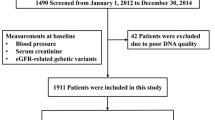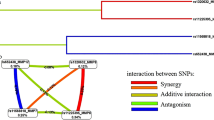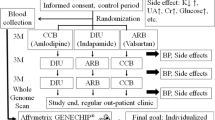Abstract
P2RY2 has an important function in the regulation of blood pressure by activating adenosine triphosphate (ATP). The aim of this study was to investigate the association between the human P2RY2 gene and essential hypertension (EH) through a haplotype-based case–control study that included two gender groups. The 273 EH patients and 255 age-matched controls were genotyped for five single-nucleotide polymorphisms (SNPs) of the human P2RY2 gene (rs4944831, rs1783596, rs4944832, rs4382936 and rs10898909). Data were analysed for men and women separately and then as a combined total group. For the total and the men only groups, the genotype distribution of the T allele of rs4944831 and the recessive model (GG vs TG+TT) of rs4944831 differed significantly between the EH patients and controls (P=0.028 and 0.019; P=0.009 and 0.008, respectively). Logistic regression showed that for the total and men groups, the TG+TT genotype of rs4944831 was more prevalent in EH patients than in the controls (P=0.026 and 0.011, respectively). For men, the overall distribution of the haplotype (SNP2-SNP4-SNP5) was significantly different between the EH patients and the controls (P=0.006). As compared with controls, the frequency of the T-A-G haplotype was significantly higher, whereas the T-C-G haplotype was significantly lower for the EH patients (P=0.001 and 0.014, respectively). In conclusion, the present results indicate that rs4944831 and the T-A-G haplotype of the human P2RY2 gene might be genetic markers for EH in Japanese men.
This is a preview of subscription content, access via your institution
Access options
Subscribe to this journal
Receive 12 digital issues and online access to articles
$119.00 per year
only $9.92 per issue
Buy this article
- Purchase on Springer Link
- Instant access to full article PDF
Prices may be subject to local taxes which are calculated during checkout

Similar content being viewed by others
References
Chackathayil J, Patel JV, Cheung B . Hypertension and genes: perspectives from this journal. J Hum Hypertens 2007; 21: 851–853.
Charchar F, Zimmerli L, Tomaszewski M . The pressure of finding human hypertension genes: new tools, old dilemmas. J Hum Hypertens 2008; 22: 821–828.
Burnstock G . Physiology and pathophysiology of purinergic neurotransmission. Physiol Rev 2007; 87: 659–797.
Ruppert V, Maisch B . Genetics of human hypertension. Herz 2003; 28: 655–662.
Bailey MA, Turner CM, Hus-Citharel A, Marchetti J, Imbert-Teboul M, Milner P et al. P2Y receptors present in the native and isolated rat glomerulus. Nephron Physiol 2004; 96: 79–90.
Hummler E, Vallon V . Lessons from mouse mutants of epithelial sodium channel and its regulatory proteins. J Am Soc Nephrol 2005; 16: 3160–3166.
Lehrmann H, Thomas J, Kim SJ, Jacobi C, Leipziger J . Luminal P2Y2 receptor-mediated inhibition of Na absorption in isolated perfused mouse CCD. J Am Soc Nephrol 2002; 13: 10–18.
Sun R, Carlson NG, Hemmert AC, Kishore BK . P2Y2 receptor-mediated release of prostaglandin E2 byIMCD is altered in hydrated and dehydrated rats: relevance to AVP-independent regulation of IMCD function. Am J Physiol Renal Physiol 2005; 289: F585–F592.
Homolya L, Watt WC, Lazarowski ER, Koller BH, Boucher RC . Nucleotide-regulated calcium signaling in lung fibroblasts and epithelial cells from normal and P2Y(2) receptor (−/−) mice. J Biol Chem 1999; 274: 26454–26460.
Cressman VL, Lazarowski E, Homolya L, Boucher RC, Koller BH, Grubb BR . Effect of loss of P2Y(2) receptor gene expression on nucleotide regulation of murine epithelial Cl(−) transport. J Biol Chem 1999; 274: 26461–26468.
Arthur DB, Akassoglou K, Insel PA . P2Y2 receptor activates nerve growth factor/TrkA signaling to enhance neuronal differentiation. Proc Natl Acad Sci USA 2005; 102: 19138–19143.
Matos JE, Robaye B, Boeynaems JM, Beauwens R, Leipziger J . K secretion activated by luminal P2Y2 and P2Y4 receptors in mouse colon. J Physiol 2005; 564: 269–279.
Chen Y, Corriden R, Inoue Y, Yip L, Hashiguchi N, Zinkernagel A et al. ATP release guides neutrophil chemotaxis via P2Y2 and A3 receptors. Science 2006; 314: 1792–1795.
Rieg T, Bundey RA, Chen Y, Deschenes G, Junger W, Insel PA et al. Mice lacking P2Y2 receptors have salt-resistant hypertension and facilitated renal Na+ and water reabsorption. FASEB J 2007; 21: 3717–3726.
Haketa A, Soma M, Nakayama T, Sato M, Kosuge K, Aoi N et al. Two medium-chain acyl-CoA synthetase genes, SAH and MACS1, are associated with plasma HDL cholesterol levels, but they are not associated with essential hypertension. J Hypertens 2004; 22: 1903–1907.
Nakayama T, Soma M, Rahmutula D, Ozawa Y, Kanmatsuse K . Isolation of the 5′-flanking region of genes by thermal asymmetric interlaced polymerase chain reaction. Med Sci Monit 2001; 7: 345–349.
Sano M, Kuroi N, Nakayama T, Sato N, Izumi Y, Soma M et al. Association study of calcitonin-receptor like receptor gene in essential hypertension. Am J Hypertens 2005; 18: 403–408.
Rahmutula D, Nakayama T, Soma M, Sato M, Izumi Y, Kanmatsuse K et al. Systematic screening of type B human natriuretic peptide receptor gene polymorphisms and association with essential hypertension. J Hum Hypertens 2001; 15: 471–474.
Nakayama T, Soma M, Kanmatsuse K, Kokubun S . The microsatellite alleles on chromosome 1 associated with essential hypertension and blood pressure levels. J Hum Hypertens 2004; 18: 823–828.
Dempster AP, Laird NM, Rubin DB . Maximum likelihood from in complete data via the EM algorithm. J R Stat Soc 1977; 39: 1–22.
Sato N, Nakayama T, Asai S, Soma M . A haplotype in the human Sur2 gene is associated with essential hypertension. J Hum Hypertens 2006; 20: 87–90.
Parr CE, Sullivan DM, Paradiso AM, Lazarowski ER, Burch LH, Olsen JC et al. Cloning and expression of a human P2U nucleotide receptor, a target for cystic fibrosis pharmacology. Proc Natl Acad Sci USA 1994; 91: 3275–3279.
Dasari VR, Sandhu AK, Mills DC, Athwal RS, Kunapuli SP . Mapping of the P2U purinergic receptor gene to human chromosome 11q 13.5-14.1. Somat Cell Mol Genet 1996; 22: 75–79.
el-Moatassim C, Dornand J, Mani JC . Extracellular ATP and cell signalling. Biochem Biophys Acta 1992; 1134: 31–45.
Burnstock G . Overview. Purinergic mechanisms. Ann NY Acad Sci 1990; 603: 1–17.
Berridge MJ . Inositol trisphosphate and diacylglcerol as second messengers. Biochem J 1984; 220: 345–360.
Guyton AC . Kidneys and fluids in pressure regulation. Small volume but large pressure changes. Hypertension 1992; 19: 12–18.
Kunzelmann K, Bachhuber T, Regeer R, Markovich D, Sun J, Schreiber R . Purinergic inhibition of the epithelial Na transport via hydrolysis of PIP2. FASEB J 2005; 19: 142–143.
Morris RW, Kaplan NL . On the advantage of haplotype analysis in the presence of multiple disease susceptibility alleles. Genet Epidemiol 2002; 23: 221–233.
O’Donnell CJ, Lindpaintner K, Larson MG, Rao VS, Ordovas JM, Schaefer EJ et al. Evidence for association and genetic linkage of the angiotensin-converting enzyme locus with hypertension and blood pressure in men but not women in the Framingham Heart Study. Circulation 1998; 97: 1766–1772.
Ono K, Mannami T, Iwai N . Association of a promoter variant of the haeme oxygenase-1 gene with hypertension in women. J Hypertens 2003; 21: 1497–1503.
Foresta C, Fossato M, Nogara A, Gottardello F, Bordon P, Di Virgilio F . Role of P2-purinergic receptors in rat leydig cell steroidogenesis. Biochem J 1996; 320: 499–504.
Huisman HW, Schutte AE, Van Rooyen JM, Malan NT, Malan L, Schutte R et al. The influence of testosterone on blood pressure and risk factors for cardiovascular disease in a black South African population. Ethn Dis 2006; 16: 693–698.
Falkner B, Sherif K, Sumner A, Kushner H . Hyperinsulinism and sex hormones in young adult African Americans. Metabolism 1999; 48: 107–112.
Erlinge D, Burnstock G . P2 receptors in cardiovascular regulation and disease. Purinergic Signal 2008; 4: 1–20.
Acknowledgements
We thank Ms K Sugama for her excellent technical assistance. This work was supported by grants from Toray Co, Ltd and the Ministry of Education, Culture, Sports, Science and Technology of Japan (High-Tech Research Center, Nihon University).
Author information
Authors and Affiliations
Corresponding author
Ethics declarations
Competing interests
The authors declare no conflict of interest.
Rights and permissions
About this article
Cite this article
Wang, Z., Nakayama, T., Sato, N. et al. The purinergic receptor P2Y, G-protein coupled, 2 (P2RY2) gene associated with essential hypertension in Japanese men. J Hum Hypertens 24, 327–335 (2010). https://doi.org/10.1038/jhh.2009.67
Received:
Revised:
Accepted:
Published:
Issue Date:
DOI: https://doi.org/10.1038/jhh.2009.67
Keywords
This article is cited by
-
Genetic polymorphisms of purinergic P2Y2 receptor were associated with the susceptibility to essential hypertension in Chinese postmenopausal women
Purinergic Signalling (2023)
-
Haplotype-based, case–control study of the receptor (calcitonin) activity-modifying protein (RAMP) 1 gene in essential hypertension
Journal of Human Hypertension (2017)
-
The touching story of purinergic signaling in epithelial and endothelial cells
Purinergic Signalling (2012)



